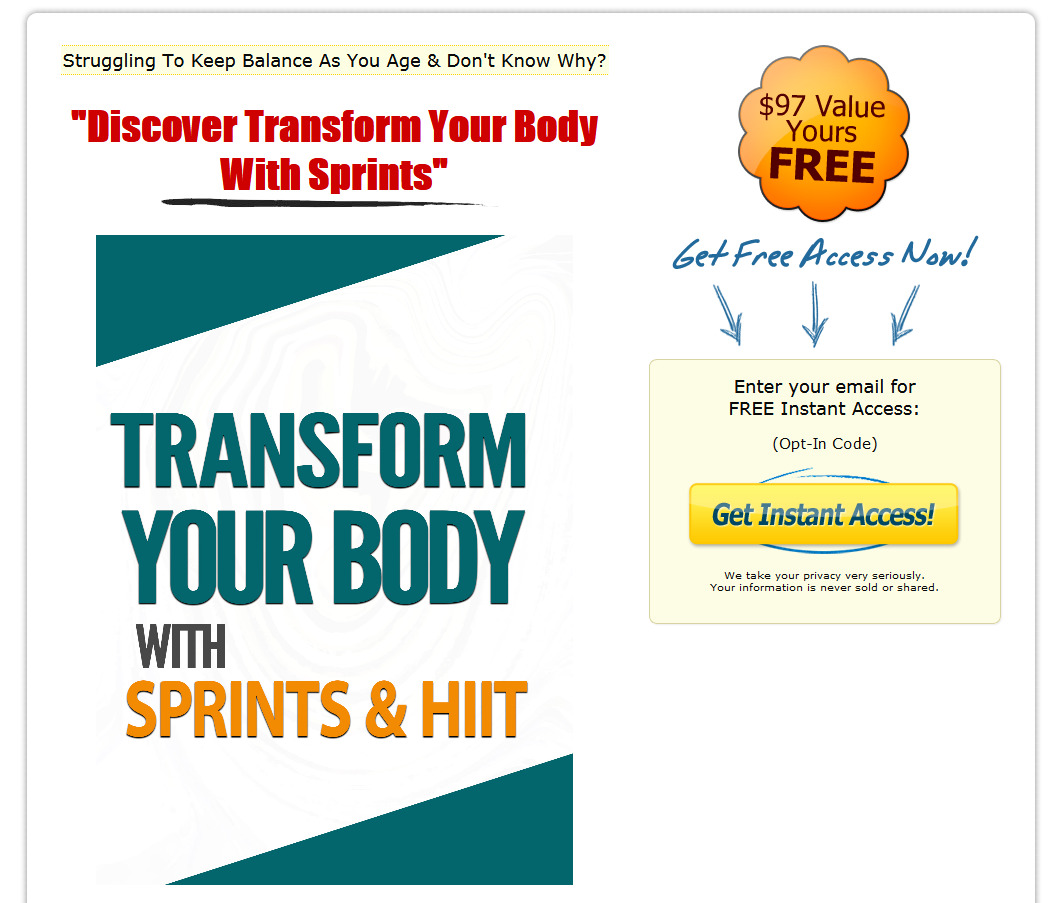Salespage Snapshot

Table of Contents
Introduction . 4
Chapter 1 – What The Heck Is HIIT? … 6
Chapter 2 – What Is The Optimal Training Zone? 9
Chapter 3 – How Often Should HIIT Be Performed …. 11
Chapter 4 – So What Makes HIIT So Special? …. 13
HIIT Promotes Muscle Growth …… 13
HIIT Burns Fat …… 15
HIIT Saves Time … 17
HIIT Boosts Energy Levels …. 19
Conclusion .. 20
Sample Content Preview
Chapter 2 – What Is The Optimal Training Zone?
As mentioned, it is all relative based upon overall fitness levels, but generally speaking, in order for HIIT to work, you need to be pushing yourself incredibly hard on the high-intensity portion of the exercise.
How hard? Well, many health experts and personal trainers recommend anything from 85% – 100% of your maximum heart rate during the high intensity portions of the exercise.
That’s right, in order for the workout to be effective you really do need to be working hard. It’s no good just jogging leisurely, or perhaps running a little faster than you do when you perform steady state cardio, because that will not work.
To achieve maximum fat burning results you need to be sprinting, and you need to be sprinting as fast as you can.
Imagine yourself racing against Usain Bolt, trying to set a new World Record, or being chased by a hungry and angry bear like the one that messed Leo DiCaprio up so much in The Revenant
Chapter 3 – How Often Should HIIT Be Performed
As you might expect, answers to this question will vary depending on whom you speak to.
Some people for example, may recommend that you perform HIIT five times per week, while others may tell you that twice per week is sufficient enough.
The general consensus however, and this is based off of science and numerous studies and hours upon hours of extensive research, have concluded that HIIT workouts should be performed no more than three times per week, when used in conjunction with other forms of exercise.
If for example, you also lift weights and are looking to tone up and build some muscle in the process, these three HIIT sessions combined with the weight lifting and resistance exercises you are performing, will be more than sufficient for transforming your body, boosting your fitness, and getting you the results that you’re looking for.
Any more than this, and you put yourself at risk of overtraining. Overtraining will result in fatigue, muscle loss, suppressed metabolism, and a lack of enthusiasm to train, and nobody wants that.
In terms of when HIIT should be performed, to be honest, it doesn’t matter all that much. Ideally however, you should perform HIIT when you are fresh, so either on a non-lifting day, or before you train. This is because, as it is so intense, if you are already tired and feeling the effects of a weight training session, you won’t be able to give 100% to your HIIT workout, and anything less than max effort will not yield the results you should be getting.
Chapter 4 – So What Makes HIIT So Special?
There are plenty of forms of cardiovascular exercise out there for you to choose from, so why is HIIT considered to be such a superior form of physical exertion. It turns out that HIIT can offer people a wide range of benefits that go far beyond those relating to losing fat and getting fitter. Some of the main benefits associated with HIIT include:
HIIT Promotes Muscle Growth
Cardio is generally not a form of exercise that we associate with muscle growth. When we think of muscle, we think of dumbbells, barbells, and hulking great bodybuilders deadlifting ridiculous amounts of weight from the floor.
However, as we mentioned in the intro to this guide, many Olympic sprinters have physiques that many amateur bodybuilders would be envious of.
Sprinting isn’t renowned for its muscle-building effects on the body, so what gives?
Well, in the human body, we have two types of muscle fibres. We have fast-twitch muscle fibres, and we have slow-twitch muscle fibres. Slow-twitch muscle fibres are those found in the muscles that we utilize for slow and steady endurance-based exercises.
Though still beneficial, these muscle fibres are not the ones that are going to give you an impressive double biceps flex to post on your Instagram. Fast-twitch muscle fibres however, are those which are responsible for generating explosive power. Explosive power like that which is needed to perform sprints for example.
With HIIT, we can actually convert slow-twitch muscle fibres into fast-twitch muscle fibres, which means that we can use HIIT to help promote increases in our lean muscle mass.
Make no mistakes, HIIT isn’t going to build anywhere near as much lean muscle mass as a typical bodybuilding routine consisting of compound and isolation movements with free weights and machines. What it will do however, is help to promote slight increases in lean muscle mass, and as you know, every little bit helps.
HIIT Burns Fat
In terms of fat loss, many personal trainers and health experts alike, consider HIIT to be the ultimate tool for losing stubborn body fat.
HIIT will help burn fat and keep people incredibly lean. When you perform HIIT, as you are working so incredibly hard, you are burning off a significant number of calories as you exercise.
Other Details- 5 Articles (TXT)
- 1 Ebook (PDF, DOC), 21 Pages
- 1 Audio (MP3)
- 2 Graphics (JPG)
- 1 Squeeze Page (HTML)
- Year Released/Circulated: 2020
- File Size: 5,606 KB
License Details:
You’re granted master resell rights, resell rights or to resell with personal use rights.
You may add this product to your PAID membership site
You may giveaway the product as a bonus when people buy through your affiliate link
You may edit the included opt-in / squeeze / landing page
You may giveaway the eBook for Lead Generation purpose
No, you may NOT edit the contents of the eBook
No, this product does NOT include private label rights. You are granted Master Resell Rights only














